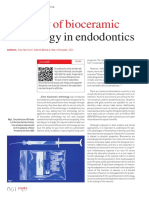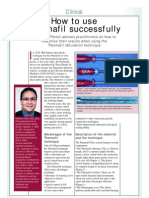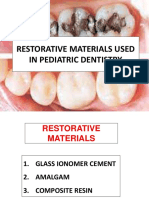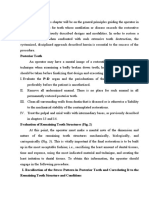The Rise of Bioceramics
The Rise of Bioceramics
Uploaded by
jananibCopyright:
Available Formats
The Rise of Bioceramics
The Rise of Bioceramics
Uploaded by
jananibOriginal Title
Copyright
Available Formats
Share this document
Did you find this document useful?
Is this content inappropriate?
Copyright:
Available Formats
The Rise of Bioceramics
The Rise of Bioceramics
Uploaded by
jananibCopyright:
Available Formats
EP USA Aug nasseh.
qxd 28/7/09 14:20 Page 1
Clinical
The rise of bioceramics
Ali Allen Nasseh presents the clinical applications of bioceramics in
endodontics
The term ‘bioceramics’ refers to biocompatible ceramic Figure 1:
EndoSequence BC
materials, applicable for biomedical or dental use. sealer (premixed in
Systematic research of ceramics for use in biomedical syringe with multiple
applications started in the early 1970s and over the past 40 tips)
years, the application of a variety of ceramics in
biomedicine has greatly expanded (Kokubo, 2008).
Therefore, when the new calcium silicate, calcium
phosphate EndoSequence bioceramic sealer and root repair
material (Brasseler USA) (Figure 1) were introduced to
endodontics, there was much excitement because their
predecessor bioceramic materials had also shown
considerable clinical success over time. However, it is
generally agreed that the limitations with the early
generation of bioceramics were their handling surgical and surgical cases will be shown. Please see pages
characteristics and non-ease of use. These challenges have XX-XX for the case figures.
now been met with the new EndoSequence bioceramic
sealer and root repair material. Conclusion
In the previous issue of Endodontic Practice (April In conclusion, bioceramic materials have excellent
2009), an introductory article listed the many benefits of biocompatibility and material properties that render them
bioceramics in both surgical and non-surgical endodontics ideal for endodontic care. The EndoSequence BC sealer and
(Koch, Brave, 2009). The benefits are so significant that the root repair material, in particular, demonstrate favorable
BC sealer is now an integral component of the clinical properties for their use as either an endodontic
EndoSequence instrumentation and obturation system and, sealer or root repair material. Furthermore, the improved
along with the new root repair material, has evolved into efficiency and mode of delivery offered by this system,
the realm of surgical endodontics. This is a natural makes it far easier to use than the previous bioceramic
progression given the fact that these particular bioceramics systems for both surgical and non-surgical applications.
have exceptional dimensional stability and do not shrink
upon setting and, consequently, remain non-resorbable References
inside the root canal and retro-preparation. Furthermore, Kokubo, T (2008) Bioceramics and their clinical applications Woodhead
the formation of calcium hydroxide as a by-product of the Publishing Limited
setting reaction produces a very high pH (12.8) rendering Koch K, Brave D (2009) Bioceramic technology – the game changer in
the material anti-bacterial during its setting time (the pH endodontics Endodontic Practice 2(2): 17-21
will decrease over the next seven days). This is an Torabinejad M, Hong CU, McDonald F, Pitt Ford TR (1995) Physical and
important physical property for a cement, particularly if it chemical properties of a new root-filling material JOE 21: 349-53
is being used as an endodontic sealer (Torabinejad, Hong, Zuang H, Shen Y, Ruse ND, Haapasalo M Antibacterial activity of
McDonald, Pitt Ford, 1995). endodontic sealers by a modifed direct contact test JOE (Accepted for
In fact, in a soon to be published article by Zuang et al, publication)
it was shown that BC sealer (iRoot SP) killed all bacteria Koch K, Brave D, (2009) A new day has dawned: the increased use of
within two minutes of contact. The authors proceed to bioceramics in endodontics Dentaltown 10(4): 39-43
explain that its potent anti-bacterial effect may be a
combination of its high pH, hydrophilic nature and its
active calcium hydroxide diffusion (Zuang, Shen, Ruse, Dr Nasseh received his dental degree from Northwestern University
Haapasalo). The BC sealer itself sets in three to four hours Dental School in 1994 and his post-doctoral endodontic training at
Harvard School of Dental Medicine in 1997, where he also completed
(the setting reaction is initiated by the moisture present in
a Masters in Medical Sciences degree in the area of bone physiology.
the dentinal tubules) and this provides ample time for
Dr Nasseh has been a clinical instructor in the post-doctoral endo
clinical use in surgical or non-surgical applications (Koch,
department at Harvard School of Dental Medicine since 1997. Dr
Brave, 2009). Additionally, the direct application of this
Nasseh is the clinical director of Real World Endo and the editor of
material into the root canal or into the retro preparation by the Harvard Dental Bulletin. He has published numerous articles and
syringe (using various tips of different diameters and lectures extensively nationally and internationally in surgical and
configurations) makes it exceedingly efficient for clinical non-surgical endodontic therapy. Dr Nasseh has a clinical private
use. endodontic practice (Micro-Surgical Endodontics) and an endodontic
Subsequently, the intent of this article is to demonstrate educational institute in Boston, MA in the Copley Plaza.
how this material is used in clinical endodontics, both non-
ENDODONTIC PRACTICE AUGUST 2009 21
EP USA Aug nasseh.qxd 28/7/09 14:20 Page 2
Clinical
Figure 2a: After final Figure 2b: EndoSequence Figure 2c: If the Figure 2d: Placement of Figure 2e: The gutta
cleaning and shaping, the BC sealer is injected into EndoSequence system of the matching cone to the percha handle is then
canal is irrigated with the coronal half of the matching GP is used, the preparation size will push severed with heat at the
NaClO final rinse and dried canal using the syringe apical third may be left the sealer apically level of the orifice or
with paper points tips in the box without any sealer below for a canal cap or a
post space
Case one
Figure 1: Tooth 14 with irreversible pulpitis following a composite Figure 2: Immediate post operative radiograph using the
restoration EndoSequence system including BC sealer and a 3mm thick layer of
bonded EndoSequence core material for an immediate seal of the
canal orifices. Cotton and Cavit is placed in the orifice
Case two
Figure 1: Tooth 3 with irreversible pulpitis Figure 2: Initial working length determination shows sharp mesial root
curvature
22 ENDODONTIC PRACTICE AUGUST 2009
EP USA Aug nasseh.qxd 28/7/09 14:20 Page 3
Clinical
Figure 3: Mid-obturation radiograph showing single .04 taper Figure 4: Post obturation distal angle radiograph of the sealer
EndoSequence gutta percha cones with BioCeramic sealer in all four showing all four canals obturated using the EndoSequence BC sealer
canals and bonded EndoSequence core material in the access opening
Case three
Figure 1: Necrotic tooth 3 with a large coronal restoration and apical Figure 2: Working length radiograph identifying all four canals
lesions of endodontic origin
Figure 3: Mid-obturation radiograph with (matching) EndoSequence Figure 4: Four months post-operative radiograph showing healing of
single cones and BC sealer apical radiolucencies. The post space has been filled with a fiber post
ENDODONTIC PRACTICE AUGUST 2009 23
EP USA Aug nasseh.qxd 28/7/09 14:21 Page 4
Clinical
Case four
Figure 1: Carious tooth 18 under an old composite Figure 2: Proper isolation, using a rubber dam and Opal Figure 3: Working length determination of all three
restoration with irreversible pulpitis and acute pain. Dam light curable resin to seal the crevices and the canals
Tooth 19 also has an old, poorly treated root canal rubber dam, completely sealing it against leakage of
with a chronic apical abscess around the mesial root saliva into the working field or leakage of sodium
hypochlorite into the mouth
Figure 4: Radiographic confirmation of root lengths Figure 5: Complete instrumentation of the canals Figure 6: After removal of the smear layer and a final
using EndoSequence files, finishing at 40/.04 in the rinse with sodium hypochlorite, the canals are dried
two mesial roots and 50/.04 in the distal root with the matching size EndoSequence paper points
Figure 7: The EndoSequence BC sealer syringe tip is Figure 8: Injection in the mesiobuccal canal Figure 9: Injection in the distal canal
inserted in each canal and a small quantity of the
sealer is inserted into each canal, coating and filling
the canals with sealer
Figure 10: Higher magnification image of canals filled Figure 11: A confirmation radiograph shows that the Figure 12: The corresponding cone for each canal is
with the bioceramic sealer from the syringe sealer has fully filled the coronal 2/3 of the canal, gently inserted. If additional space is available (e.g.
leaving the apical 1/3 free of sealer. This space will an oval shaped canal), an additional cone may be
be filled after the introduction of the matching gutta placed in that space
percha cone into the canal, which like a piston,
pushes the coronal sealer apically
xx ENDODONTIC PRACTICE FEBRUARY 2009
EP USA Aug nasseh.qxd 28/7/09 14:21 Page 5
Clinical
Figure 13: Image showing all canals filled with an Figure 14: The gutta percha is then seared off using Figure 15: After condensation, the excess sealer is
additional cone in the distal canal due to its oval heat at the orifice level and a plugger is used to best cleaned using an ultrasonic tip with water for
shape. The heated instrument is used in the condense the gutta percha apically at the level of the about 10 seconds in the chamber
mesiobuccal canal orifice, preparing to sear off the orifice. Use the correct size plugger, one that matches
handle the gutta perchas cross sectional diameter at that
specific level and does not put pressure on the dentin.
Apical pressure will transfer the condensation force
along the length of the EndoSequence gutta percha
(which has a higher molecular density and does not
deform as readily). This property allows the gutta percha
cone to act as an extension of the plugger
Figure 16: Following obturation, it is best to seal the orifices Figure 17: A 2-3mm thick layer of EndoSequence dual cure,
immediately, no matter what sealer you use (non-eugenol based reinforced composite is placed and cured in place
sealers). After Phosphoric acid etching, a later generation bonding
agent is used
Figure 18: Cotton and Cavit are then inserted in the chamber Figure 19: The angled final radiograph shows an adequately prepared
and obturated root canals with a definitive seal in the chamber. The
patient will then see the restorative dentist for the ensuing core and
crown. Tooth #19 also requires retreatment next
ENDODONTIC PRACTICE AUGUST 2009 24
EP USA Aug nasseh.qxd 28/7/09 14:21 Page 6
Clinical
Case five
Figure 1: Necrotic tooth 19 with a large periapical radiolucency Figure 2: Immediate post-operative radiograph of the tooth obturated
with the EndoSequence BioCeramic sealer
Figure 3: Six months follow-up of the tooth showing restoration of the Figure 4: Another angle showing complete periapical healing six
access and healing in the periapex months post-operatively
Case six
1 2 3
Figure 1: Pre-operative radiograph showing failed root canal
Figure 2: Bioceramic paste retrofills injected into retropreparations
Figure 3: Immediate post-operative radiograph (three BC paste retrofills at the apecies)
Figure 4: Four months and 21 day recall of the case. Further healing in progress and no
clinical symptoms present
xx ENDODONTIC PRACTICE AUGUST 2009
You might also like
- High Yield NBME Images AnnotatedDocument84 pagesHigh Yield NBME Images AnnotatedNareman Abd El HadeNo ratings yet
- Extra-Coronal Restorations: Robert Wassell Francis Nohl Jimmy Steele Angus Walls EditorsDocument459 pagesExtra-Coronal Restorations: Robert Wassell Francis Nohl Jimmy Steele Angus Walls EditorsMohamedAlaaNo ratings yet
- Indirect Composite RestorationsDocument88 pagesIndirect Composite RestorationsShubham KingraNo ratings yet
- Int Endodontic J - 2022 - Terauchi - Present Status and Future Directions Removal of Fractured InstrumentsDocument25 pagesInt Endodontic J - 2022 - Terauchi - Present Status and Future Directions Removal of Fractured Instruments吳國豪No ratings yet
- NEW BSN CURRICULUM - CMO 15 RevisedDocument2 pagesNEW BSN CURRICULUM - CMO 15 RevisedchoobiNo ratings yet
- Oral Wound Healing: Cell Biology and Clinical ManagementFrom EverandOral Wound Healing: Cell Biology and Clinical ManagementHannu LarjavaNo ratings yet
- Rheumatology History Taking NotesDocument6 pagesRheumatology History Taking NotesWan Nur AfifahNo ratings yet
- Brand Plan For Dienogest by Saqib AltafDocument13 pagesBrand Plan For Dienogest by Saqib AltafSakib ZabooNo ratings yet
- Bioceramic in EndodonticsDocument2 pagesBioceramic in EndodonticsMuhammad MoazzamNo ratings yet
- Endodontic ArmamentariumDocument29 pagesEndodontic ArmamentariumAbdulSamiNo ratings yet
- Minimally Invasive Periodontal Therapy: Clinical Techniques and Visualization TechnologyFrom EverandMinimally Invasive Periodontal Therapy: Clinical Techniques and Visualization TechnologyNo ratings yet
- Bioceramics in Endodontics - A ReviewDocument11 pagesBioceramics in Endodontics - A ReviewMelliya heptaniaNo ratings yet
- Estrogenicity of CompositesDocument8 pagesEstrogenicity of CompositesSubhashini RajshekarNo ratings yet
- MTA Versus Biodentine: Review of Literature With A Comparative AnalysisDocument5 pagesMTA Versus Biodentine: Review of Literature With A Comparative AnalysisAishwarya Mahesh KumarNo ratings yet
- Dentin Substitutes: By-Dr. Rishika Luhach Mdspg1 YearDocument25 pagesDentin Substitutes: By-Dr. Rishika Luhach Mdspg1 Yearmansi mamgainNo ratings yet
- Hybrid Ceramics in Dentistry: A Literature ReviewDocument5 pagesHybrid Ceramics in Dentistry: A Literature ReviewNguyên TrầnNo ratings yet
- Efficacy of Ribbond and A Fibre Post On The Fracture Resistance of Reattached Maxillary Central Incisors With Two Fracture PatternsDocument6 pagesEfficacy of Ribbond and A Fibre Post On The Fracture Resistance of Reattached Maxillary Central Incisors With Two Fracture PatternsPao JanacetNo ratings yet
- Bulk-Fill Composite RestorationsDocument9 pagesBulk-Fill Composite RestorationssusethNo ratings yet
- Root Resorption Diagnosis, Classification and Treatment Choices Based On Stimulation FactorsDocument8 pagesRoot Resorption Diagnosis, Classification and Treatment Choices Based On Stimulation FactorsAhmad AssariNo ratings yet
- REVIEW - The Microtensile Bond TestDocument12 pagesREVIEW - The Microtensile Bond TestElmer Acevedo0% (1)
- 7 8 TH Crown Tucker TechniqueDocument5 pages7 8 TH Crown Tucker TechniqueNaghman ZuberiNo ratings yet
- Microbiology of EndodonticsDocument38 pagesMicrobiology of EndodonticsAndi Ika Purnama PutriNo ratings yet
- Apex Locators (NITHYA)Document27 pagesApex Locators (NITHYA)nithyaNo ratings yet
- BiodentineDocument19 pagesBiodentineflofloflfkdfjaofh100% (1)
- Influence of The Color of Composite Resin Foundation and Luting Cement On The Final Color of Lithium Disilicate Ceramic SystemsDocument6 pagesInfluence of The Color of Composite Resin Foundation and Luting Cement On The Final Color of Lithium Disilicate Ceramic SystemsDanny Eduardo RomeroNo ratings yet
- Porcelain Fused To Metal CrownsDocument5 pagesPorcelain Fused To Metal CrownsCitra Dwi PrastiwieNo ratings yet
- Manapallil 4ed Basic Dental MaterialsDocument17 pagesManapallil 4ed Basic Dental MaterialsManika100% (1)
- Devices and Methods For Preheating Prewarming Dental Resin CompositesDocument4 pagesDevices and Methods For Preheating Prewarming Dental Resin CompositesMADA100% (1)
- ART 56bioceramic SealerDocument8 pagesART 56bioceramic SealerRuchi ShahNo ratings yet
- Kim Regenerative EndodonticsDocument51 pagesKim Regenerative Endodonticsrasagna reddyNo ratings yet
- Evaluation of Mineral Trioxide Aggregate (MTA) Versus Calcium Hydroxide Cement (Dycal ) in The Formation of A Dentine Bridge: A Randomised Controlled TrialDocument7 pagesEvaluation of Mineral Trioxide Aggregate (MTA) Versus Calcium Hydroxide Cement (Dycal ) in The Formation of A Dentine Bridge: A Randomised Controlled TrialCHOUCHOU12485No ratings yet
- Nano DentistryDocument104 pagesNano DentistryShameena KnNo ratings yet
- Single Visit EndodonticsDocument5 pagesSingle Visit EndodonticsSreena VenugopalanNo ratings yet
- Fiber Reinforced Post and CoreDocument4 pagesFiber Reinforced Post and CoreAnca MantuNo ratings yet
- ISSN: 0975-833X: Research ArticleDocument9 pagesISSN: 0975-833X: Research ArticleSuryo HannaNo ratings yet
- Class V Composite Preparation and Restoration On Human ToothpdfDocument17 pagesClass V Composite Preparation and Restoration On Human ToothpdfAnastasia IrimescuNo ratings yet
- Direct Cuspal CoverageDocument8 pagesDirect Cuspal CoverageLuLu NikhlaturNo ratings yet
- Bioceramics in Endodontics Viresh Chopra 2024 332 PP, IsBN 9781119898467Document329 pagesBioceramics in Endodontics Viresh Chopra 2024 332 PP, IsBN 9781119898467Henry Herrera100% (1)
- Etched Cast RestorationsDocument41 pagesEtched Cast Restorationssharanya chekkarrajNo ratings yet
- Hemisection of Multirooted Tooth A Case Report PROQUESTDocument5 pagesHemisection of Multirooted Tooth A Case Report PROQUESTMelba Zaragoza NavarroNo ratings yet
- How To Use ThermafilDocument7 pagesHow To Use ThermafilEvan ChiangNo ratings yet
- Restorative Materials (Dental Composite)Document60 pagesRestorative Materials (Dental Composite)فواز نميرNo ratings yet
- Restorative MaterialDocument91 pagesRestorative MaterialShivani DubeyNo ratings yet
- MTA-Based Root Canal Sealers PDFDocument6 pagesMTA-Based Root Canal Sealers PDFAndrew GarciaNo ratings yet
- Practice: Restoration of The Root-Filled Tooth: Pre-Operative AssessmentDocument10 pagesPractice: Restoration of The Root-Filled Tooth: Pre-Operative AssessmenteletiNo ratings yet
- Banerjee - 2018 - Selective Removal of Carious DentinDocument16 pagesBanerjee - 2018 - Selective Removal of Carious DentinAli Al-QaysiNo ratings yet
- Regen EndoDocument88 pagesRegen EndoJitender ReddyNo ratings yet
- Adhesive Restoration in Posterior Teeth Using Semidirect TechniqueDocument4 pagesAdhesive Restoration in Posterior Teeth Using Semidirect Techniquemartariwansyah100% (1)
- Endodontic MicrobiologyDocument219 pagesEndodontic Microbiologyrasagna reddy100% (1)
- The Spectrum of Composites:New Techniques and Materials: Background. Clinical ImplicationsDocument5 pagesThe Spectrum of Composites:New Techniques and Materials: Background. Clinical ImplicationsThant Sin ChangNo ratings yet
- Pre-Warming of Dental CompositesDocument9 pagesPre-Warming of Dental Compositesandres castroNo ratings yet
- Badly Broken MarzoukDocument68 pagesBadly Broken MarzoukHend MohamedNo ratings yet
- 1 Cbct-Evaluation of Remaining Dentin Thickness and Fracture Resistance of Conventional and Conservative Access and Biomechanical Preparation in Molars Using Cone-beam Computed Tomography- An in Vitro StudyDocument4 pages1 Cbct-Evaluation of Remaining Dentin Thickness and Fracture Resistance of Conventional and Conservative Access and Biomechanical Preparation in Molars Using Cone-beam Computed Tomography- An in Vitro StudyalbertaugustineNo ratings yet
- Clinical Techniques For Composite PlacementDocument4 pagesClinical Techniques For Composite PlacementRizta RiztiaNo ratings yet
- GicDocument155 pagesGicNikita KadamNo ratings yet
- Materiale Ceramice in StomatologieDocument23 pagesMateriale Ceramice in StomatologieMogos PaulNo ratings yet
- Endo Update 2006 PDFDocument21 pagesEndo Update 2006 PDFRamona MateiNo ratings yet
- Cementation of Indirect Restorations - An Overview of Resin CementsDocument6 pagesCementation of Indirect Restorations - An Overview of Resin CementsNaoki MezarinaNo ratings yet
- Abrasion Resistance and Microhardness of Six Artificial Acrylic Teeth - AnDocument7 pagesAbrasion Resistance and Microhardness of Six Artificial Acrylic Teeth - Ansai projectNo ratings yet
- Fiber Post System - Critical ReviewDocument7 pagesFiber Post System - Critical ReviewKirti SharmaNo ratings yet
- Kutler's Thery PDFDocument10 pagesKutler's Thery PDFSam RoyNo ratings yet
- Apical Limit of Root Canal Instrumentation and Obturation, PDocument10 pagesApical Limit of Root Canal Instrumentation and Obturation, PRamona MateiNo ratings yet
- Doctors ListDocument17 pagesDoctors ListRikke LegarthNo ratings yet
- Burn Injuries FdneDocument25 pagesBurn Injuries FdneRonit ChandNo ratings yet
- Sample+Simulation+Scenarios 08-2017 MedPro+GroupDocument62 pagesSample+Simulation+Scenarios 08-2017 MedPro+GroupGursimran RajvanshNo ratings yet
- 2013 Emerging Importance of HolobiontsDocument9 pages2013 Emerging Importance of HolobiontsaleiviNo ratings yet
- ISSVA Classification 2018 PDFDocument20 pagesISSVA Classification 2018 PDFIgor YonekuraNo ratings yet
- Nephritis Fact SheetDocument3 pagesNephritis Fact SheetAsish GeiorgeNo ratings yet
- Tata AwalDocument4 pagesTata AwalnurulNo ratings yet
- 2017 ESMO Essentials For Clinicians Head Neck CancersDocument99 pages2017 ESMO Essentials For Clinicians Head Neck CancersisraelcsnzNo ratings yet
- Catalytic Antibody ProductionDocument14 pagesCatalytic Antibody ProductionAnisam Abhi100% (1)
- Frozen Shoulder 20 FebruaryDocument29 pagesFrozen Shoulder 20 Februaryangga nugrahaNo ratings yet
- Subarachnoid Hemorrhage - ClinicalKeyDocument17 pagesSubarachnoid Hemorrhage - ClinicalKeyvalentina amayaNo ratings yet
- Dr. Gupta Says, No One Must Die of Cancer Except Out of CarelessnessDocument2 pagesDr. Gupta Says, No One Must Die of Cancer Except Out of CarelessnessMyrelle Da Jose Sario0% (1)
- Case Study. VsDocument19 pagesCase Study. VsBabylayne PangcatanNo ratings yet
- Anti-Inflammatory Drugs: Bachelor of PharmacyDocument37 pagesAnti-Inflammatory Drugs: Bachelor of Pharmacydeepak_1430% (2)
- Skin Integrity and Wound CareDocument38 pagesSkin Integrity and Wound CareMiu MiuNo ratings yet
- Aziz 2016Document8 pagesAziz 2016FEBRIA RAMADONANo ratings yet
- Erythroblastic SynartesisDocument11 pagesErythroblastic SynartesisKata TölgyesiNo ratings yet
- Lecture Notes On PsychiatryDocument38 pagesLecture Notes On PsychiatrysrossgellNo ratings yet
- Drug Mechanis MOF Action Indicatio N and Rationale Contra Indication S Side Effects Nursing ConsiderationDocument1 pageDrug Mechanis MOF Action Indicatio N and Rationale Contra Indication S Side Effects Nursing ConsiderationJordz PlaciNo ratings yet
- Question 1: Choose The Most Suitable Word or Phrase (A, B, C, or D) To Fill in Each Blank (20 Points)Document8 pagesQuestion 1: Choose The Most Suitable Word or Phrase (A, B, C, or D) To Fill in Each Blank (20 Points)Linh ChiNo ratings yet
- 7 The Sexual SelfDocument5 pages7 The Sexual SelfMicsjadeCastilloNo ratings yet
- Lecture 1 Course Specification of General BacteriologyDocument36 pagesLecture 1 Course Specification of General BacteriologyNedhal Mahmoud KaleefahNo ratings yet
- Benharm 2Document7 pagesBenharm 2Hurriya Nur AldillaNo ratings yet
- انترفيو الحضاناتDocument16 pagesانترفيو الحضاناتMai GamalNo ratings yet
- Anesthesia and Acupuncture: Gerhard Litscher, Holger Simonis, Wolfgang KroöllDocument13 pagesAnesthesia and Acupuncture: Gerhard Litscher, Holger Simonis, Wolfgang KroöllPspduntanDuaribusebelasNo ratings yet
- Bds Third Professional Examination 2007 General Medicine Table of Specifications Chapter Wise Distribution of Mcqs and SeqsDocument5 pagesBds Third Professional Examination 2007 General Medicine Table of Specifications Chapter Wise Distribution of Mcqs and SeqsMed StudentNo ratings yet

























































































